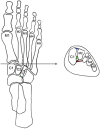Lisfranc complex injuries management and treatment: current knowledge
- PMID: 35891929
- PMCID: PMC9301181
Lisfranc complex injuries management and treatment: current knowledge
Abstract
Lisfranc complex injuries are a spectrum of midfoot and tarsometatarsal (TMT) joint trauma, more frequent in men and in the third decade of life. Depending on the severity of the trauma can range from purely ligamentous injuries, in low-energy trauma, to bone fracture-dislocations in high-energy trauma. A quick and careful diagnosis is crucial to optimize management and treatment, reducing complications and improving functional outcomes in the middle and long-term. Up to 20% of Lisfranc fractures are unnoticed or diagnosed late, above all low-energy trauma, mistaken for simple midfoot sprains. Therefore serious complications such as post-traumatic osteoarthritis and foot deformities are not uncommon. Clinically presenting with evident swelling of the midfoot and pain, often associated with joint instability of the midfoot. Plantar region ecchymosis is highly peculiar. First level of examination is X-Ray performed in 3 projections. CT scan is useful to detect nondisplaced fractures and minimal bone sub-dislocation. MRI is the gold standard for ligament injuries. The major current controversies in literature concern the management and treatment. In stable lesions and in those without dislocation, conservative treatment with immobilization and no weight-bearing is indicated for a period of 6 weeks. Displaced injuries have worse outcomes and require surgical treatment with the two main objectives of anatomical reduction and stability of the first three cuneiform-metatarsal joints. Different surgical procedures have been proposed from closed reduction and percutaneous surgery with K-wire or external fixation (EF), to open reduction and internal fixation (ORIF) with transarticular screw (TAS), to primary arthrodesis (PA) with dorsal plate (DP), up to a combination of these last 2 techniques. There is no superiority of one technique over the other, but what determines the post-operative outcomes is rather the anatomical reduction. However, the severity of the injury and a quick diagnosis are the main determinant of the biomechanical and functional long-term outcomes.
Keywords: Lisfranc fracture-dislocations; Lisfranc injury; Lisfranc ligament; fusion; midfoot dislocation; tarsometatarsal joint.
IJPPP Copyright © 2022.
Conflict of interest statement
None.
Figures



References
-
- Welck MJ, Zinchenko R, Rudge B. Lisfranc injuries. Injury. 2015;46:536–541. - PubMed
-
- Lau S, Bozin M, Thillainadesan T. Lisfranc fracture dislocation: a review of a commonly missed injury of the midfoot. Emerg Med J. 2017;34:52–56. - PubMed
-
- DeOrio M, Erickson M, Usuelli FG, Easley M. Lisfranc injuries in sport. Foot Ankle Clin. 2009;14:169–186. - PubMed
-
- Wiley JJ. The mechanism of tarso-metatarsal joint injuries. J Bone Joint Surg Br. 1971;53:474–482. - PubMed
Publication types
LinkOut - more resources
Full Text Sources
